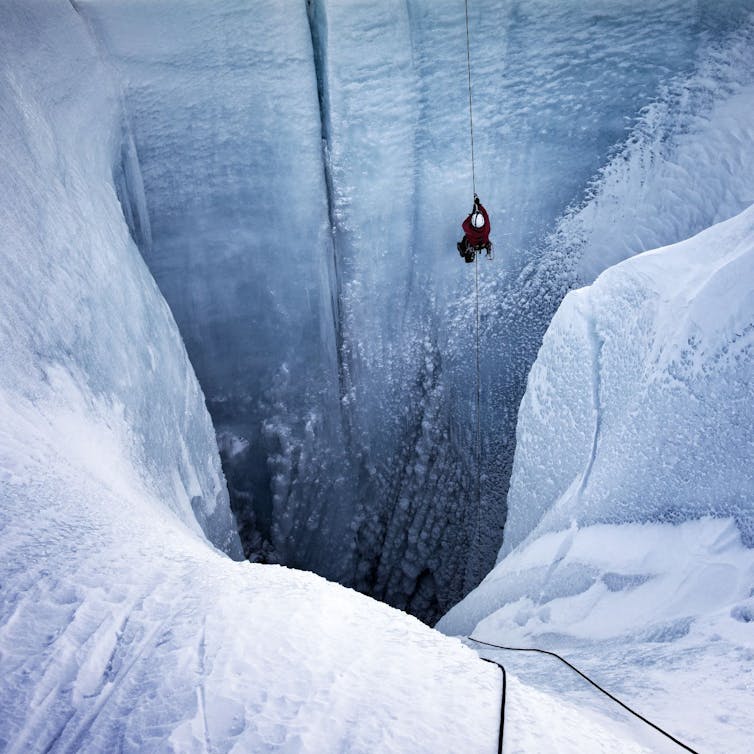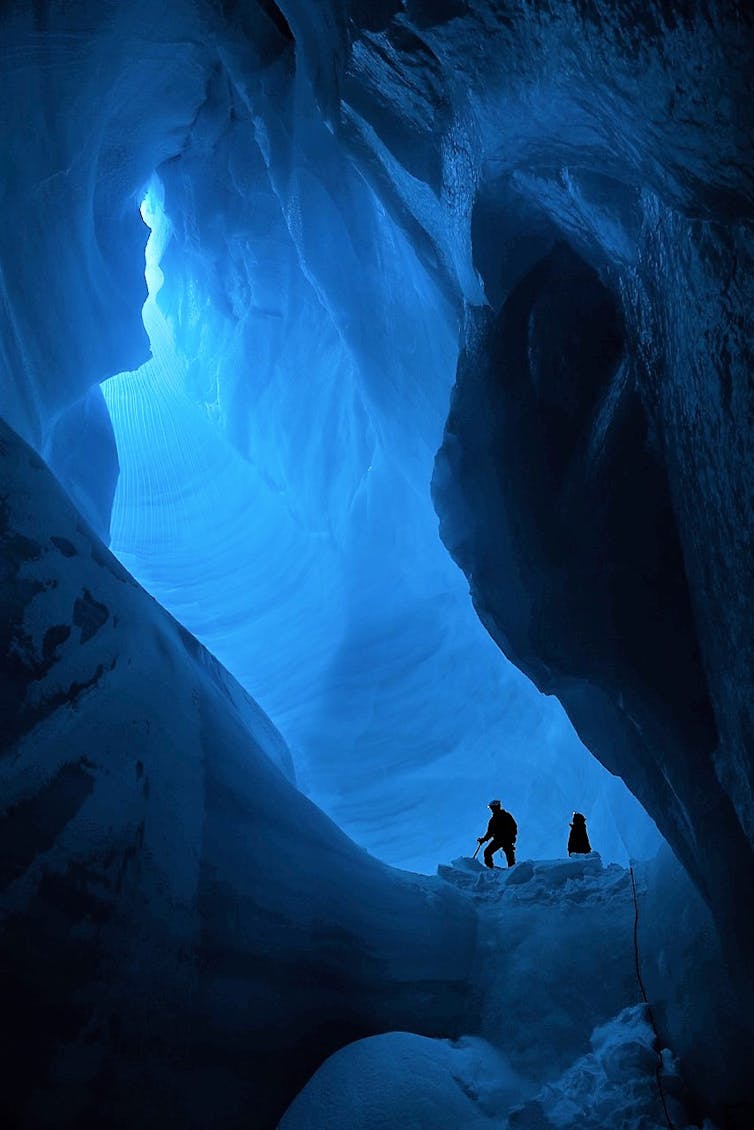Meltwater is hydro-fracking Greenland’s ice sheet through millions of hairline cracks – destabilizing its internal structure

I’m striding along the steep bank of a raging white-water torrent, and even though the canyon is only about the width of a highway, the river’s flow is greater than that of London’s Thames. The deafening roar and rumble of the cascading water is incredible – a humbling reminder of the raw power of nature.
As I round a corner, I am awestruck at a completely surreal sight: A gaping fissure has opened in the riverbed, and it is swallowing the water in a massive whirlpool, sending up huge spumes of spray. This might sound like a computer-generated scene from a blockbuster action movie – but it’s real.
Alun Hubbard discusses the mechanics of moulins and rappels into one in the second half of this introduction to the Greenland ice sheet.
A moulin is forming right in front of me on the Greenland ice sheet. Only this really shouldn’t be happening here – current scientific understanding doesn’t accommodate this reality.
As a glaciologist, I’ve spent 35 years investigating how meltwater affects the flow and stability of glaciers and ice sheets.
This gaping hole that’s opening up at the surface is merely the beginning of the meltwater’s journey through the guts of the ice sheet. As it funnels into moulins, it bores a complex network of tunnels through the ice sheet that extend many hundreds of meters down, all the way to the ice sheet bed.
When it reaches the bed, the meltwater decants into the ice sheet’s subglacial drainage system – much like an urban stormwater network, though one that is constantly evolving and backing up. It carries the meltwater to the ice margins and ultimately ends up in the ocean, with major consequences for the thermodynamics and flow of the overlying ice sheet.
Scenes like this and new research into the ice sheet’s mechanics are challenging traditional thinking about what happens inside and under ice sheets, where observations are extremely challenging yet have stark implications. They suggest that Earth’s remaining ice sheets in Greenland and Antarctica are far more vulnerable to climate warming than models predict, and that the ice sheets may be destabilizing from inside.
NASA’s GRACE satellites capture Greenland’s ice loss from 2002-2021.
This is a tragedy in the making for the half a billion people who populate vulnerable coastal regions, since the Greenland and Antarctic ice sheets are effectively giant frozen freshwater reservoirs locking up in excess of 65 meters (over 200 feet) of equivalent global sea level rise. Since the 1990s their mass loss has been accelerating, becoming both the primary contributor to and the wild card in future sea level rise.
How narrow cracks become gaping maws in ice
Moulins are near-vertical conduits that capture and funnel the meltwater runoff from the ice surface each summer. There are many thousands across Greenland, and they can grow to impressive sizes because of the thickness of the ice coupled with the exceptionally high surface melt rates experienced. These gaping chasms can be as large as tennis courts at the surface, with chambers hidden in the ice beneath that could swallow cathedrals.
But this new moulin I’ve witnessed is really far from any crevasse fields and melt lakes, where current scientific understanding dictates that they should form.

In a new paper, Dave Chandler and I demonstrate that ice sheets are littered with millions of tiny hairline cracks that are forced open by the meltwater from the rivers and streams that intercept them.
Because glacier ice is so brittle at the surface, such cracks are ubiquitous across the melt zones of all glaciers, ice sheets and ice shelves. Yet because they are so tiny, they can’t be detected by satellite remote sensing.
Under most conditions, we find that stream-fed hydrofracture like this allows water to penetrate hundreds of meters down before freezing closed, without the crack’s necessarily penetrating to the bed to form a full-fledged moulin. But, even these partial-depth hydrofractures have considerable impact on ice sheet stability.
As the water pours in, it damages the ice sheet structure and releases its latent heat. The ice fabric warms and softens and, hence, flows and melts faster, just like warmed-up candle wax.

The stream-driven hydrofractures mechanically damage the ice and transfer heat into the guts of the ice sheet, destabilizing it from the inside. Ultimately, the internal fabric and structural integrity of ice sheets is becoming more vulnerable to climate warming.
Emerging processes that speed up ice loss
Over the past two decades that scientists have tracked ice sheet melt and flow in earnest, melt events have become more common and more intense as global temperatures rise – further exacerbated by Arctic warming of almost four times the global mean.
The ice sheet is also flowing and calving icebergs much faster. It has lost about 270 billion metric tons of ice per year since 2002: over a centimeter and a half (half an inch) of global sea-level rise. Greenland is now, on average, contributing around 1 millimeter (0.04 inches) to the sea level budget annually.
A 2022 study found that even if atmospheric warming stopped now, at least 27 centimeters – nearly 1 foot – of sea level rise is inevitable because of Greenland’s imbalance with its past two decades of climate.
Understanding the risks ahead is crucial. However, the current generation of ice sheet models used to assess how Greenland and Antarctica will respond to warming in the future don’t account for amplification processes that are being discovered. That means the models’ sea-level rise estimates, used to inform Intergovernmental Panel on Climate Change (IPCC) reports and policymakers worldwide, are conservative and lowballing the rates of global sea rise in a warming world.

Our new finding is just the latest. Recent studies have shown that:
- Warming ocean currents are intruding into the Antarctic and Greenland coastlines, flowing under the ice shelves to undercut outlet glaciers and destabilize their calving fronts.
- Increasing rainfall across the Greenland ice sheet not only depletes snow accumulation, it also accelerates surface melting and ice flow.
- Algae and microbes, along with surface snowpack melt, darken the ice sheet surface, absorbing more solar radiation, which also accelerates ice melt.
- Superimposed ice slabs within the snowpack are forming across the accumulation zone, forming an impermeable barrier that depletes meltwater retention and drives extraordinary runoff.
- Water at the base of the ice sheet thaws and softens the frozen bed, thereby triggering basal sliding and accelerating interior ice sheet flow to the margins.
In the last months, other papers also described previously unknown feedback processes underway beneath ice sheets that computer models currently can’t include. Often these processes happen at too fine a scale for models to pick up, or the model’s simplistic physics means the processes themselves can’t be captured.
Two such studies independently identify enhanced submarine melting at the grounding line in Greenland and Antarctica, where large outlet glaciers and ice streams drain into the sea and start to lift off their beds as floating ice shelves. These processes greatly accelerate ice sheet response to climate change and, in the case of Greenland, could potentially double future mass loss and its contribution to rising sea level.

Current climate models lowball the risks
Along with other applied glaciologists, “structured expert judgment” and a few candid modelers, I contend that the current generation of ice sheet models used to inform the IPCC are not capturing the abrupt changes being observed in Greenland and Antarctica, or the risks that lie ahead.
Ice sheet models don’t include these emerging feedbacks and respond over millennia to strong-warming perturbations, leading to sluggish sea level forecasts that are lulling policymakers into a false sense of security. We’ve come a long way since the first IPCC reports in the early 1990s, which treated polar ice sheets as completely static entities, but we’re still short of capturing reality.
As a committed field scientist, I am keenly aware of how privileged I am to work in these sublime environments, where what I observe inspires and humbles. But it also fills me with foreboding for our low-lying coastal regions and what’s ahead for the 10% or so of the world’s population that lives in them.
is Professor of Glaciology, Arctic Five Chair, University of Tromsø.
This article is republished from The Conversation under a Creative Commons license. Read the original article here.
Disclosure statement:
Alun Hubbard acknowledges funding from the Research Council of Norway (Centers of Excellence: CAGE & iC3), The Academy of Finland (PROFI4: Arctic Interactions) and is additionally affiliated to Oulun Yliopisto (Oulu University), Arctic Basecamp and La Venta Esplorazioni Geografiche.